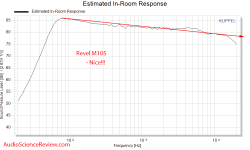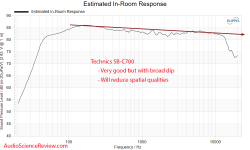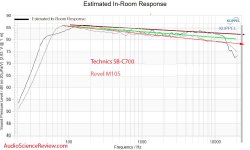Stereophile measured 0.003%, but at lower level (5mW into 110ohm).
Spec is 0.005% at 1V.
Amir measured 0.007% at 2V.
All second harmonic.
I see no issue. Very low distortion. Amir hates the sound. Fine. Its his subjective opinion. He hates pass labs. I am sure he made his mind about the sound long before he even listened to it 🙂
Spec is 0.005% at 1V.
Amir measured 0.007% at 2V.
All second harmonic.
I see no issue. Very low distortion. Amir hates the sound. Fine. Its his subjective opinion. He hates pass labs. I am sure he made his mind about the sound long before he even listened to it 🙂
Hello,Stereophile measured 0.003%, but at lower level (5mW into 110ohm).
Spec is 0.005% at 1V.
Amir measured 0.007% at 2V.
All second harmonic.
I see no issue. Very low distortion. Amir hates the sound. Fine. Its his subjective opinion. He hates pass labs. I am sure he made his mind about the sound long before he even listened to it 🙂
While Pass amps are possibly worth every penny if you are into audio jewelry or bragging rights, believe Amir and most others here know that great performance can be had for a fraction of the price. Depend on what you consider important. Personally, my budget is a real priority.
You do get to decide on what you want and the priorities involved. IMHO.
A pseudo science audio trope that just won't die. Depending on absolute phase relationships between series connected devices the amplifier's 2nd order waveform asymmetry can either cancel or add to the 2nd order asymmetry generated by the headphones. In short measuring the headphone acoustic output is the only way to confirm whether the HPA-1 is adding to or subtracting from the 2nd order harmonic distortion reaching the listener with their particular headphones. Or speakers.If you can't hear it then why claiming second harmonic sounds better?
Pass should consider adding an absolute phase reversal switch to the HPA-2.
You'd have to buy one of the cheaper Kias.and pay the car installments?
That is why Nelson Pass encourage and support DIY. He gave away and support multitude amp designs for free since the 70s.While Pass amps are possibly worth every penny if you are into audio jewelry or bragging rights, believe Amir and most others here know that great performance can be had for a fraction of the price....
I've measured same with single ended tube amps on the bench. A prototype sounded best at about 0.3% 2nd at one watt into the cheap PSB used for casual bench monitoring. The UMIK showed why, across significant portions of the frequency band the PSB's THD dropped 10 db by simply reversing the speaker leads.certain phase of H2 actually cancel some of distortion of dynamic driver.
Maybe to you but not to Amir.Looks to me that amp measures very well. Low distortion in general, mainly second harmonic, very little third. What's not to like.
I have nor heard it, i wish i had, so i can not comment on sound.
But the measurements look very good to me.
That is why we need to listen to and preferably measure the gadgets we use. Blindly trusting some authority would just confuse us even more.I've measured same with single ended tube amps on the bench. ...
Yet he hides the facts that matters.Maybe to you but not to Amir.
See the comments by Amir. He's very critical about it it seems to me...What bad measurements?
I don't say he's right, but he compares it to other headphone amplifiers and then he (he not me! And I did not start this thread either.) concludes it measures mediocre and sounds inferior too. That's his judgement and that's all there is just another opinion on this matter just as we all have opinions of our own some substantiated, others just by gut feeling or loyality to a brand.
I was going to suggest seeing his review of the Technics SB-C700 speaker. The original post had unfavorable comparisons to a Revel (surprise) M105. Screen shots from the ASR review which judges the Technics to have a broad midrange dip show how that was determined. Note the disparity between where ASR's estimated in room response intersects the high frequency max between the two models. Drop the high end of the Technics line ~2 dB as he did for the Revel and the relative 'broad dip' evaporates. TLDR version: owning even SOTA measuring systems don't confer objectivity.Amir hates the sound.
More disconcerting the Revel comparison along with its 'wow wow wow' assessment of the Revel's audible superiority have since been stealth edited from the main review. Some of the discussion survives in the comments.
Attachments
Be realistic, why would I listen to a faulty device?I would not dismiss it untill i heard it. Have you?
I read it all... but you didn't, apparently.You should read again what everyone wrote about...
Tpa6120 is not just the best bang for the buck...it had proven to give the best possible results with 99.9999999 % of the entire world market's headphones .
TPA6120 is very nice amp and it has -112.5 dB THD, according to Texas Instruments datasheet. On the other hand, Benchmark HP4 has measured -138 dB THD. So, this proves TPA6120 do not give the best possible results. Also, this proves your assertion is wrong. Besides, 0.0000001% of the total world population of 8 billion is just 800 people, which clearly proves you are wrong on this also, because number of sold expensive headphone amplifiers clearly is higher than 800 units.
What exactly is faulty?Be realistic, why would I listen to a faulty device?
For some reason I'm attached to a thesis of mine for a good number of years now that relates to Dolby processing, which is that harmonics need to be treated as noise , similarly to what a mastering engineer does when he cuts all the unnecesary material that alters the album cohesion.If two instruments have fundamental to armonic interference, he'll choose to cut either the fundamental or the harmonics of one instrument to make the passage more clear.Less is more in the recording bussiness .
Harmonics need to be clearly audible or above the audible treshold, or nonexistent .Dealing with harmonic content at subliminal levels is a recipee for desaster .
We like tubes for being tubes , we don't like tubes for behaving like 1970's op-amps.
I see a lot of guys struggling with evaluating designs that have THD around 80db...You should not even touch an audio equipment having distortions in the range of 60 to 85db.It's where distorsions are perceived as subliminal noise by the brain.
Lower distortions than -85db...good!
Higher distortions than -60db ...debatable !
In between Neeeeh!
Harmonics need to be clearly audible or above the audible treshold, or nonexistent .Dealing with harmonic content at subliminal levels is a recipee for desaster .
We like tubes for being tubes , we don't like tubes for behaving like 1970's op-amps.
I see a lot of guys struggling with evaluating designs that have THD around 80db...You should not even touch an audio equipment having distortions in the range of 60 to 85db.It's where distorsions are perceived as subliminal noise by the brain.
Lower distortions than -85db...good!
Higher distortions than -60db ...debatable !
In between Neeeeh!
Last edited:
And that can be true for every other reviewer, including all reviewers from Stereophile. 🙂Stereophile measured ...
... Amir hates the sound. Fine. Its his subjective opinion. He hates pass labs. I am sure he made his mind about the sound long before he even listened to it 🙂
Damn it! You count the .9999....Never thought about it 🙂)))I read it all... but you didn't, apparently.
TPA6120 is very nice amp and it has -112.5 dB THD, according to Texas Instruments datasheet. On the other hand, Benchmark HP4 has measured -138 dB THD. So, this proves TPA6120 do not give the best possible results. Also, this proves your assertion is wrong. Besides, 0.0000001% of the total world population of 8 billion is just 800 people, which clearly proves you are wrong on this also, because number of sold expensive headphone amplifiers clearly is higher than 800 units.
Good for you that you can hear the difference between -112.5dB and -138dB THD.
I and the rest of the world envy you!
... and the SB-C700 elevated high frequency spectra above 3kHz are pirceing the ears much more than the smooth Revel M105. Actually, it depends where the ear-brain will catch up - it is either midrange drop, or elevated highs... which neither is good.I was going to suggest seeing his review of the Technics SB-C700 speaker. The original post had unfavorable comparisons to a Revel (surprise) M105. Screen shots from the ASR review which judges the Technics to have a broad midrange dip show how that was determined. Note the disparity between where ASR's estimated in room response intersects the high frequency max between the two models. Drop the high end of the Technics line ~2 dB as he did for the Revel and the relative 'broad dip' evaporates. TLDR version: owning even SOTA measuring systems don't confer objectivity.
Your question leads me to the conclusion that you know absolutely nothing about electronics. On Aliexpress and other Chinese sites, you can find a lot of devices with a certain "sound characteristic" for a lot less money. It's more satisfying that you can buy dozens of them for the money that this device is sold for. When you like what you hear, you pack it in a box and that's a real DIY. You can also try different wires and insulations to see how they sound.What exactly is faulty?
Last edited:
Maybe its a faulty reviewer 🙂Be realistic, why would I listen to a faulty device?
- Status
- Not open for further replies.
- Home
- Amplifiers
- Headphone Systems
- Pass Labs HPA-1 bad joke.


